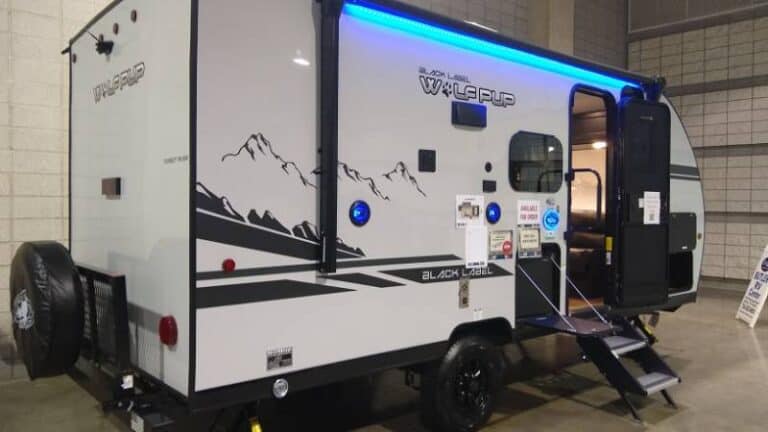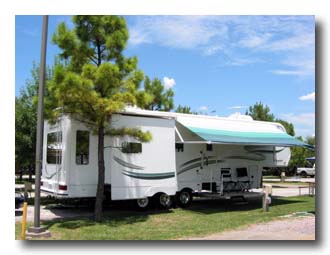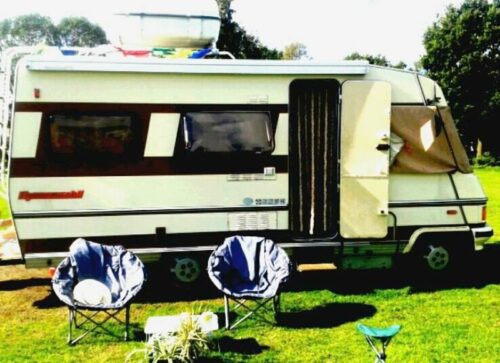Whether buying a new or used RV, the exercise of determining the fair market value (FMV) is well worth the effort to avoid over-paying. Each transaction has a seller and a buyer with opposing financial goals—this article provides information to help the buyer minimize the cost while allowing a reasonable profit for the seller.
For the most accurate FMV, use as many of the techniques described in this article as possible. Allow variance in the FMV for condition, options, mileage, upgrades, number of available units, etc.
What Is Fair Market Value (FMV)?
According to Investopedia:
The fair market value is the price an asset would sell for on the open market when certain conditions are met.
The conditions are: the parties involved are aware of all the facts, are acting in their own interest, are free of any pressure to buy or sell, and have ample time to make the decision.
In other words, fair market value is the happy, non-zero-sum intersection of where the seller has made a profit and the buyer has gotten a good deal.
Some of the product links are on this page are affiliate links. If you click through and purchase, I may receive a small commission at no extra cost to you. See Privacy Policy. Thanks!
Table of Contents
Determining Fair Market Value for a NEW RV

What’s the Book Value?
Unfortunately, “book value” does not really exist for RVs!
Calculating how much your RV is worth is far more difficult than for a home or automobile.
- Home values are set by your local housing market supply and demand, comparable “comp” properties, and individual home appraisals (which are regulated by the FDIC). Selling prices are publicly available on real estate MLS listings.
- Automobile MRSPs and selling prices are carefully tracked by third parties, such as Kelly Blue Book and LMC Automotive. This information is publicly available and is based on incredible amounts of data! In fact, discriminatory pricing has largely been curtailed by the transparency and credibility of these tools.
No such transparency or extensive third-party data tracking is present in the American RV market.
Manufactures often do not disclose MSRPs on their websites. Actual selling prices are not as carefully tracked by giant third-party analysts, leading to incomplete data and sampling bias. It’s a bit of a Wild West out there!
Psst! There are websites out there offering “blue book” valuation services for your RV. Vet and research these services before using them! Make sure the service is a credible source and not a camouflaged phishing or lead generation operation.
What's a Fair Price for an RV?
Even though reliable “blue book” values don’t exist for the RV world, you can still get a reasonable estimate for your RV’s fair market value.
We list a few of the most popular and credible services below.
None of these services factor in the construction quality of an RV. They are all strictly based on sales trends and forecasting algorithms.
We recommend using the Low Retail Price (+ up to 10%, not exceeding the Average Retail Price) as a FMV for a new RV.
NADA Guides
The most popular (albeit not the most accurate) new RV book pricing tool is the NADA Guide. Many buyers turn to it first because it provides a quick answer.
You should consult the NADA Guides, but don’t make it your only source. Its primary limitation for RV’s is that the prices are statistically derived and not from actual selling prices. If you will be relying heavily on the NADA Guides as a buyer, I suggest you use the “Low Retail” number in the online guide or the “Used Wholesale” number in the printed guide as your target price.
NADA allows you to search for Low Retail/Average Retail/Suggested List Price based on:
- RV type
- Year
- Manufacturer
- Brand
- Model
- Trim Options
You must provide your zip code to receive an online selling price estimate.
NADA Guide is free to use online. You can purchase the NADA Recreation Vehicle Appraisal Guide from J.D. Power, though.
RVT.com Price Checker
The RVT Price Checker allows you to search for High/Medium/Low/Suggested prices based on:
- RV type
- Year
- Manufacturer
- Brand
- Model
You can compare results from RVT to estimates from J.D. Power on the same page!
Their estimates are partially based on analysis of list and/or sale prices from the thousands of RVs being sold at RVT.com.
RV Trader Price Checker
The RV Trader Price Checker allows you to search for Average/Low/High prices based on:
- RV type
- Year
- Manufacturer
- Brand
- Model
You can search nationwide or limit yourself to your local zip code!
Their estimates are partially based on analysis of list and/or sale prices from the thousands of RVs being sold at RVTrader.com
If you want to attempt to calculate your camper or motorhome’s Fair Market Value yourself, you’ll need to understand the following.
What Do Dealers Pay?
Fair market value for a new RV can be roughly derived by adding an acceptable margin of profit to the dealer’s invoice price (aka wholesale price).
You see, a dealer purchases the RV from the OEM at the invoice price and resells it to you, the customer, for an upcharge as the retailer and service provider.
The manufacturer often provides an Manufacturer’s Suggested Retail Price (MRSP). The dealer will typically sell at or below this amount at a discount.
Sometimes, you can find the MSRP of your RV by visiting our RV Manufacturers List, finding your manufacturer, and then clicking through to their site.
But some OEMs simply do not post their MSRPs online.
And many RV manufacturers and dealers leverage MSRP values to create forced scarcity and false discounts. MRSP values are intentionally set higher than what the market will bear. Dealers can then sell the unit at “15% off – July only!” and still make their normal profit.
Typical dealer markup ranges from 20-40% of the invoice price.
Ballpark Estimate
To calculate a Fair Market Value estimate, follow these steps:
- Obtain an MSRP approximation from NADA, your dealer, or another trustworthy source.
- Multiply this number by 0.85.
Example: $36,544 MSRP x 0.85 = $31,062 FMV.
Do not pay more than this number!
Sadly, there is no hard-and-fast rule for calculating an exact markup margin.
For instance, some smaller trailers have 40% markups because the amount of time it takes the dealership to process the sale for a $15,000 13-ft mini travel trailer is the same as to process a $120,000 luxury fifth-wheel.
Margins vary with market conditions. With supply is low and demand is high, such as during the COVID-19 pandemic, markups are sky-high.
When the travel industry crashed after the Great Recession of 2009, markups took a nose-dive as well.
Unfortunately, unless you have insider knowledge of the RV industry, the invoice price will be difficult to attain. But if you can get your hands on it, then you can use the invoice price as a bartering tool to reduce the markup to a reasonable percentage.
To my knowledge, there are no publicly accessible databases where you can see RV dealer invoice costs. And most dealerships will jealously guard this information.
P.S. Don’t be waylaid by so-called “search tools.” For instance, I reviewed the website SeeDealerCost.com, which purports to show actual RV dealer costs. I sampled 14 RVs from five different brands, in all cases, the ratio between the “invoice cost” and the MSRP was the same: 45%. I suspect this website is merely dividing MSRP numbers pulled from a different database, like NADA.
What Do Other Customers Pay?
You can estimate an RV’s fair market value by comparing similar models across regional dealerships.
By “similar” models, we mean the same brand, same/similar floorplan, same trim level, from the same manufacturer.
You may not be able to find an exact match. However, the brand and model size should be equivalent.
Many RV dealerships are now posting their inventory with standard pricing online. A quick Google search will show results within your area.
Direct comparisons between local dealerships may be more useful than the regional estimates provided by online estimators.
You can use this information to pitch dealer vs. dealer and drive down the cost through competition.
In fact, here’s a book on the subject from J.D. Gallant at the RV Consumer Group:How to Outwit Any Auto, Truck, or RV Dealer Every Time (included in M – RV Consumer Group
What’s the Actual Out-the-Door Cost?
Some RV dealerships tack on upsells, charges and fees at every opportunity: PDI inspections, service contracts, document preparation fees, or “mandatory” accessory packages.
(I’ve even heard of dealerships trying to sell hitch receiver pins to customers for a measly $2).
You need to know the out-the-door price, with all required fees and charges, from your dealership.
And if you plan to finance through your dealer, you need a full roster of your contract fees, interest rate, and other financial details as well. You don’t want to “save” $1,000 on the RV purchase price only to lose it all over in an unfair interest rate or early payoff fees!
Add Depreciation to Used RV FMV
Another way to determine the FMV for a new recreational vehicle is to find the FMV of a similar used model and add back the depreciation. If you do not have the RVCG’s depreciation schedule, then adding back 25% to a 1-2 year old model should get you in the ballpark. For example, let’s say you found a one-year-old model in excellent condition. By using the techniques described in the USED RV FMV section, you determine that the used model’s fair market value is $48,000. To estimate the new FMV, divide the used FMV by the inverse of the depreciation percentage, like this: $48,000 / 0.75 = $64,000.
Determining Fair Market Value for a USED RV

When finding out the Fair Market Value for a used RV, we recommend starting with a detailed understanding of that vehicle’s quality.
A great deal of research is performed by the non-profit 501(c) RV Consumer Group. You can see their full list of paid downloads for brand and model ratings here.
RVCG
For 50 years, the RV Consumer Group has been a watchdog of the unregulated RV industry. Today, the RVCG publishes extensive documentation regarding RV safety, RV brand quality, RV recalls, and other RV industry information.
RVCG does not provide direct pricing information online. However, we recommend you compare their notes on brand quality to the NADA Guide estimates and purchase accordingly.
The RVCG has compiled price statistics for most RV brands and models in their member publications. This information is invaluable to shoppers of new and used RV’s alike and contains a Price Guide section for each model with the following information:
- Average price paid for this brand/model as a percentage of the SLP.
- Average list price when new.
- Depreciation schedule.
You’ve heard it said that a fair price is the amount a buyer is willing to pay and a seller is willing accept. This is very true, but you also have to consider market conditions to bring the two sides together. These conditions are largely dictated by statistical data derived from completed sales.
Before we begin, however, you should understand that RVs undergo severe depreciation!
- Year 1: 20%
- Year 2: 25%
- Year 3: 30%
- Year 4: 35%
- Year 5: 40%
As you can see, RVs drop about 20% in value from new-to-used, and each year adds about 5% deprecation loss.
This tends to level off after Year 5. It takes 8-10 years for an RV to hit a full 50% loss in value, although this is somewhat for faster for most towables compared to motorhomes.
As a quick n’ dirty Fair Market Value estimate for a used RV, find the MSRP of that RV when it was new (from NADA), and then account for the depreciation.
Let’s look at a few techniques for determining FMV of a used recreational vehicle.
NADA Guides
Again, the easiest source for an estimated Fair Market Value for a used RV is the NADA Guide from J.D. Power.
You should consult the NADA Guides, but don’t make it your only source. Its primary limitation for RVs is that the prices are statistically derived and not from actual selling prices. If you will be relying heavily on the NADA Guides as a buyer, I suggest you use the “Low Retail” number in the online guide or the “Used Wholesale” number in the printed guide as your target price.
NADA allows you to search for Low Retail/Average Retail/Suggested List Price based on:
- RV type
- Year
- Manufacturer
- Brand
- Model
- Trim Options
You must provide your zip code to receive an online selling price estimate.
NADA Guide is free to use online. You can purchase the NADA Recreation Vehicle Appraisal Guide from J.D. Power, though.
Actual Selling Prices
By far the best way to determine FMV is by observing the actual selling prices of similar units.
As discussed in the New RV FMV section, you can use the following resources to search for estimated market prices for new AND used RVs and campers:
The following sites don’t provide averaged sale prices, but you can manually compare similar models for sale:
PPL Motor Homes
PPL Motor Homes is a consigner in Houston, Texas. It is the largest RV consignment dealer in the country. Having purchased an RV from them in 2004, I can tell you firsthand that my buying experience with PPL has been pleasant. They are nice enough to post their own selling prices on the following pages:
- Class A Diesel Motor Homes
- Class A Gasoline Motor Homes
- Class B & C Motor Homes
- Fifth Wheels
- Travel Trailers
You can also visit their main Price Checker “blue book” and Price Comparison page here.
eBay Prices
Even if you have no interest in buying or selling on eBay, it is a valuable resource for determining selling prices. Examining final bid prices on RV’s similar to the one you are considering will give you a good idea of what those units are worth. Here is how you look up the final prices on completed listings:
- Go to the RV category on the eBay Motors web site.
- Enter your search criteria, such as “monaco diesel”, and put a check mark in the “Completed listings” box under “Search Options” on the left side of the page.
- In the results ignore items that say “Reserve Not Met” and those with a zero in the “Bid” column—these items did not sell.
- Review the other items to find a model most similar to the one you are interested in and make a note of the final bid amount in the “Price” column.
Occasionally you will see asking prices far above the FMV for almost-new RV’s. When you see this, chances are the seller paid too much for the new unit and, naturally, wants to recoup as much of their investment as possible. Unfortunately, the chances of these folks getting anywhere near their asking price is slim. The time to minimize resale losses was back when the new unit was purchased, by doing as much research as possible.
Local “Comps”
When in doubt, visit your local online marketplace and see what comparable RVs and campers are selling for.
Popular marketplaces include:
- Craiglist
- Facebook Marketplace
Get a Quote
Why not just get a quote? You don’t need to own the RV to submit information! If you know the year, make, model, location and condition, you can get a quote.
Try out the Good Sam RV Valuator for a quick quote, which will forward your submission to your nearest Gander Mountain or Camping World store (so use at your own risk!)
Andy Herrick is a blogging nerd, #8 Enneagram, wannabe bread baker, INTJ, RV industry professional, and small business entrepreneur. He can be found hanging out with his lovely wife and family, skiing, cycling, climbing, hiking, and convincing anyone who will listen why dogs aren’t really that great of pets. Also, he runs this website.










